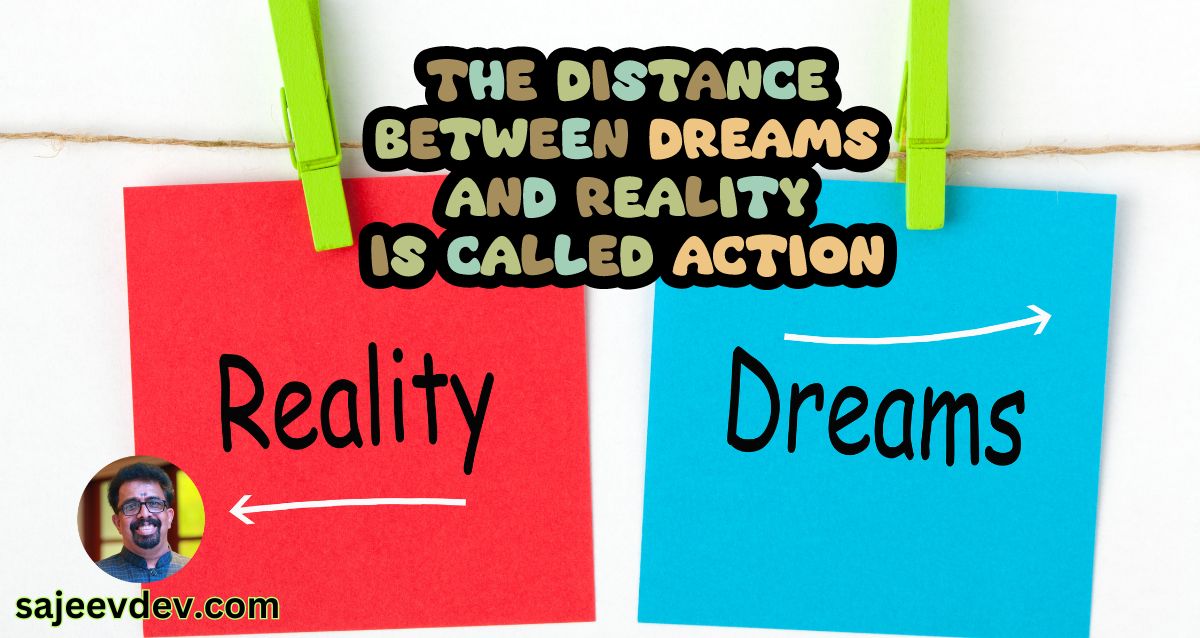The Dream as a Starting Point
Dreams represent the visions we hold for our future, encapsulating our deepest desires and aspirations. They serve as a guiding star, illuminating the path toward our goals and ambitions. At its core, a dream is an idea or longing that inspires an individual to strive for something greater. This could range from personal achievements, such as pursuing a passion, to broader societal impacts, like contributing to community development. The significance of dreams cannot be understated—they catalyze motivation and ignite our potential.
Having substantial dreams acts as a powerful motivator in life. When individuals set their sights on what they aspire to achieve, they cultivate a sense of purpose. This intrinsic motivation propels them to take actions that align with their ambitions. For example, Nobel Prize-winning author Gabriel García Márquez envisioned a future where his storytelling could resonate across cultures. His dream of writing magical realism was not merely a personal aspiration; it transformed literary landscapes and gave a voice to many. Such instances exemplify how dreams can forge new paths and inspire not only the dreamer but also others around them.
Moreover, envisioning a desired future can be instrumental in propelling individuals forward. Those who dare to dream big often find that their aspirations push them beyond their perceived limitations. Take Oprah Winfrey, who rose from humble beginnings. Driven by her dream of creating a platform for transformative conversations, she transcended societal barriers and built an empire based on her vision. Her success exemplifies the profound impact of dreaming boldly.
In essence, dreams lay the foundational blocks upon which goals are constructed. Each individual’s dream is unique, offering a distinct direction for personal fulfillment and societal contribution. Recognizing the value of these dreams is the first step in bridging the gap toward turning them into reality.
Recognizing the Reality
Every individual nurtures dreams, aspirations that often represent a desired state of life or accomplishment. However, the journey toward realizing these dreams is frequently obstructed by a myriad of challenges that reflect the often harsh realities of life. Acknowledging these challenges is an essential step in the pursuit of one’s goals. Practical limitations, such as financial constraints, lack of resources, or insufficient time, can create considerable barriers. These limitations can translate into feelings of frustration, disillusionment, and even despair.
Moreover, societal expectations and norms also play a significant role in shaping one’s path. Individuals are often inclined to conform to the perceived standards set by their communities, which may not necessarily align with their personal dreams and desires. This pressure can manifest as a daunting force, discouraging individuals from exploring unconventional paths or pursuing aspirations that diverge from societal consensus. Thus, the process of recognizing these external influences becomes pivotal in maintaining focus on personal goals.
Another prominent challenge stems from personal fears and insecurities. The prospect of failure looms large for many, instilling an apprehension that can hinder progress. Doubts about one’s abilities, fear of judgment, and the anxiety associated with stepping outside one’s comfort zone can lead to inaction. Acknowledging these personal fears is essential, as it allows individuals to confront their anxieties head-on and devise strategies to overcome them.
Nevertheless, while it is crucial to face the realities that lie in the way of our dreams, it is equally important to retain a steadfast vision of what those dreams entail. Striking a balance between dreaming ambitiously and adopting a pragmatic approach can set the stage for making tangible progress toward fulfilling one’s aspirations. Identifying constraints and fears should serve as a foundation for a more resilient journey rather than a deterrent to pursuing dreams. Recognizing reality does not equate to losing hope; rather, it is the first step toward creating actionable paths to success.
Understanding the Gap: Dream vs. Reality
The distinction between dreams and reality can often be viewed as a metaphorical gap that many individuals encounter throughout their personal and professional journeys. This gap represents the discrepancy between one’s aspirations and the tangible outcomes that life presents. Several factors contribute significantly to this divide, primarily the absence of necessary resources, sufficient knowledge, or a supportive environment. Recognizing these elements is crucial for individuals as they navigate their paths toward achieving their dreams.
Firstly, the lack of resources can be a formidable barrier. Resources may include financial means, time, or even access to education and mentorship. For instance, an aspiring entrepreneur may possess a promising idea but find themselves limited by insufficient funding or a lack of guidance on executing their vision. Such obstacles emphasize the importance of identifying and securing the resources required to transform one’s aspirations into reality.
Secondly, knowledge plays a pivotal role in bridging the gap between dreams and reality. Individuals often find themselves facing complexities that they are unprepared to tackle. Without the necessary skills or understanding of their chosen field, the journey toward actualizing their goals can seem daunting. This is where proactive learning and skill development become essential, enabling individuals to navigate challenges effectively and gain confidence in their abilities.
Moreover, the absence of a supportive network can exacerbate feelings of isolation and discouragement. Emotional support from family, friends, or communities can act as a catalyst for motivation, helping individuals sustain their pursuit of dreams despite setbacks. When individuals are unaware of the emotional impact that this gap can create, it may lead to frustration and self-doubt. Conversely, recognizing the existence of this divide can empower individuals to take actionable steps, fostering a sense of determination and resilience as they strive to bridge the gap between their dreams and their reality.
The Power of Action
Action serves as the fundamental bridge between mere dreams and tangible realities. It is through various forms of action, whether incremental steps or bold movements, that individuals begin to transform aspirations into achievable outcomes. These actions are crucial for progress, as they not only pave the way for dreams to materialize but also empower individuals with a sense of agency and direction. Each small action taken can accumulate over time, creating a momentum that propels one forward toward larger goals.
The psychological impact of taking action cannot be overstated. Engaging in purposeful activities fosters confidence, as individuals witness their capabilities unfold in response to their efforts. For instance, consider a person who dreams of becoming a writer. By setting aside time daily to write, even if only for a few minutes, they begin to see their skills improve and their voice become more defined. This consistent action builds both proficiency and self-assurance within their craft.
Additionally, significant leaps of action can also lead to noteworthy transformations. An individual yearning for a career change may choose to attend networking events, enroll in courses, or apply for positions that reflect their ambitions. Such decisive actions not only increase opportunities but also inspire others to take similar steps. The stories of people who have achieved their dreams through determined actions exemplify this reality. For instance, renowned entrepreneurs often share that their success stemmed from calculated risks and persistent effort, reinforcing the power of action in redefining one’s life trajectory.
In the journey to realize dreams, it is evident that action—regardless of its scale—is a vital ingredient. By translating intentions into concrete activities, individuals maximize their potential to turn aspirations into accomplishments, creating a pathway to their desired future.
Developing an Action Plan
Creating a structured action plan is a fundamental step in transforming abstract dreams into achievable goals. An effective action plan begins with setting specific, measurable, attainable, relevant, and time-bound (SMART) goals. By defining clear objectives, individuals gain a focused direction that enhances motivation. For instance, instead of stating a desire to ‘get fit,’ a more specific goal would be ‘to exercise for 30 minutes at least five times a week for the next three months.’ This clarity helps to guide one’s efforts and makes tracking progress easier.
Identifying the resources required to accomplish these goals is the next essential component. Resources may include time, money, skills, and support from family or friends. A thorough assessment of available resources can aid in determining what additional support may be needed. For instance, if advancing a career is a dream, one might need access to educational courses or workshops. Understanding the resources at one’s disposal allows for better planning and execution of the action steps.
Creating a timeline is another crucial aspect of developing an action plan. Timelines can help in breaking down larger goals into smaller, manageable tasks with deadlines. For instance, if the goal is to publish a book, one might set deadlines for drafting chapters, editing, and seeking publication. This segmentation of tasks fosters a sense of accomplishment as each deadline is met, keeping motivation levels high.
Prioritizing tasks is vital for effective progress. Individuals should assess which tasks will bring the most significant results relative to their dreams. A methodical approach to prioritization often leads to enhanced productivity. Regularly revisiting and adjusting the action plan, as necessary, will ensure ongoing alignment with the overarching dreams. Overall, the development of a structured action plan transforms aspirations into actionable steps, paving the way for tangible success.
Overcoming Obstacles to Action
Taking actionable steps toward achieving dreams often encounters significant obstacles that can hinder progress. Among these barriers, fear of failure stands out as a predominant factor. Many individuals find themselves paralyzed by the prospect of not succeeding, which can prevent them from even starting their journey. Addressing this fear involves developing a mindset that reframes failure as an essential aspect of growth. Recognizing that many successful individuals encountered failures before achieving their goals can be a motivating factor in this transformation.
Another common hurdle is procrastination, a behavior that disrupts momentum and diverts focus from purposeful activities. Procrastination can stem from a variety of causes, including perfectionism and feeling overwhelmed by large tasks. Strategies for overcoming this barrier include breaking projects into smaller, manageable tasks and setting deadlines to create a sense of urgency. By implementing these techniques, individuals can foster a proactive approach that encourages sustained action.
Lack of confidence is also a critical obstacle that many face when trying to take steps forward. Individuals may doubt their capabilities or fear that their efforts will not yield the desired outcome. Building self-confidence can be achieved through setting realistic goals, celebrating small wins, and seeking mentorship from those who have successfully navigated similar challenges. A supportive network can play an invaluable role in reinforcing belief in one’s abilities and providing encouragement during setbacks.
Real-world examples illustrate these strategies in action. For instance, a once-timid entrepreneur transformed her business dreams into reality by tackling her fear of failure through gradual exposure to risk-taking. In another case, an aspiring writer who frequently procrastinated found success by establishing a writing group, which fostered accountability and discipline. Such illustrations highlight the importance of addressing these obstacles, showcasing that with determination and the right approaches, barriers to action can be effectively overcome.
The Continuous Nature of Action
Achieving dreams is often perceived as a single milestone, a momentary triumph that signifies success. However, the reality is that taking action is a continuous process that extends beyond that pivotal moment. Consistency, perseverance, and adaptability are essential elements that foster ongoing progress toward one’s aspirations. It is crucial to recognize that each step taken forms part of a larger journey, where the cumulative effect of sustained action can lead to substantial achievements.
Consistency is vital in the pursuit of dreams, as it helps to establish habits and routines that promote regular progress. By integrating small, manageable tasks into daily life, individuals can pave a clear path toward their goals. These routines may encompass time management strategies, setting aside specific hours for focused work, or engaging in regular practice to enhance skills. Over time, these consistent efforts serve to build momentum, turning initial small actions into significant advances.
Furthermore, perseverance plays a critical role in this continuous journey. Setbacks and challenges are an inevitable part of any ambitious endeavor. Individuals committed to their dreams must cultivate resilience, pushing through obstacles without losing sight of their objectives. Developing a mindset that embraces failure as a learning opportunity rather than a discouragement can greatly enhance one’s ability to maintain sustained action over time.
Adaptability also becomes essential when pursuing dreams. The ability to adjust plans and strategies in response to changing circumstances can be the difference between success and stagnation. Flexibility enables individuals to explore alternative paths or to pivot when facing unforeseen challenges, thereby ensuring continued progress.
In conclusion, recognizing the continuous nature of action is vital for anyone striving to achieve their dreams. By embracing consistency, perseverance, and adaptability, individuals can sustain their efforts and navigate the dynamic landscape of their aspirations effectively.
Celebrating Small Wins
As individuals strive to achieve their dreams, it is essential to recognize the importance of celebrating small victories along the way. Every step taken toward one’s ambitions, no matter how minor it may seem, contributes to the larger journey. Acknowledging these small wins fosters a sense of accomplishment and motivation, propelling individuals forward in their pursuit of greatness. When milestones are celebrated, the journey becomes less daunting and more rewarding, creating a positive reinforcement loop that encourages continued effort and dedication.
Moreover, celebrating small successes cultivates a culture of appreciation for progress. This recognition can be as simple as acknowledging the completion of a challenging task, meeting a weekly goal, or receiving positive feedback. Such moments of recognition are not just about the win itself; they serve as reminders of the progress made and the resilience developed along the way. Individuals are more likely to stay committed to their objectives when they feel appreciated for their hard work and dedication.
There are numerous practical methods to celebrate these milestones. For instance, one might choose to treat themselves to their favorite meal or partake in a well-deserved day off after achieving a goal. Additionally, sharing these victories with friends, family, or colleagues can amplify their significance. Public acknowledgment of accomplishments, whether through social media or in-person gatherings, strengthens bonds and garners support from a community that values progress. Setting up a reward system can also be effective; establishing specific, tangible rewards for reaching defined milestones can encourage an ongoing commitment to the journey. Ultimately, celebrating small wins transforms the process of achieving dreams into a more enjoyable and fulfilling experience. It reinforces the idea that each small step deserves recognition, thus paving the way for sustained motivation and growth.
Turning Dreams into Reality
As we have explored throughout this discussion, the transformative power of action cannot be overstated in the journey of realizing one’s dreams. It is often said that dreams remain just dreams until we take decisive steps toward them. The essential role of action in bridging the gap between aspirations and reality is a theme evident in various spheres of life. From personal ambitions to professional endeavors, purposeful action is the catalyst that spurs change and paves the way for success.
Key points from our exploration highlight that understanding one’s dreams is merely the first step. The real essence lies in crafting a practical plan that encompasses actionable goals. By setting clear, achievable targets, individuals can create a roadmap leading toward their ultimate aspirations. Moreover, resilience and persistence play crucial roles in this journey; obstacles and setbacks are often part of the process. Therefore, adapting a mindset focused on learning and growth can empower individuals to remain steadfast to their goals. Action is not merely about movement; it is about informed, calculated moves toward the desired outcome.
To inspire you further, consider the words of the renowned author, C.S. Lewis, who said, “You are never too old to set another goal or to dream a new dream.” This sentiment perfectly encapsulates the boundless potential that lies within each person. We each have the ability to reignite our dreams through action, regardless of where we stand in life. I encourage you to reflect on your aspirations and to take that crucial first step, no matter how small it may be. Remember, every significant journey begins with a single action.
As you move forward, embrace the power within you to shape your reality. The bridge between dreams and accomplishment only strengthens with dedicated action and belief in oneself. Your dreams are within reach—it’s time to act.









